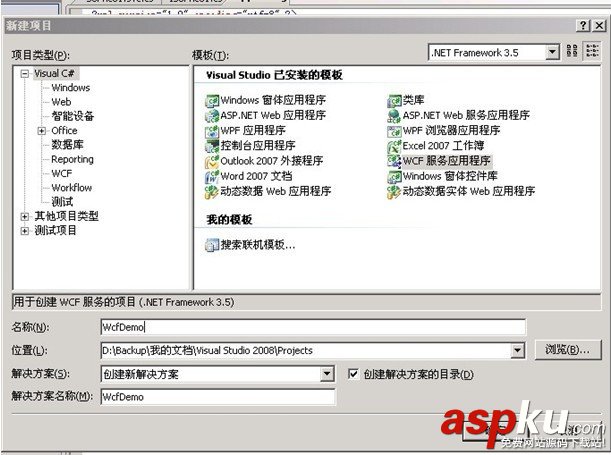想调用一个方法很容易,直接代码调用就行,这人人都会。其次呢,还可以使用反射。不过通过反射调用的性能会远远低于直接调用——至少从绝对时间上来看的确是这样。虽然这是个众所周知的现象,我们还是来写个程序来验证一下。比如我们现在新建一个Console应用程序,编写一个最简单的Call方法。
class Program
{
static void Main(string[] args)
{
}
public void Call(object o1, object o2, object o3) { }
}
Call方法接受三个object参数却没有任何实现,这样我们就可以让测试专注于方法调用,而并非方法实现本身。于是我们开始编写测试代码,比较一下方法的直接调用与反射调用的性能差距:
static void Main(string[] args)
{
int times = 1000000;
Program program = new Program();
object[] parameters = new object[] { new object(), new object(), new object() };
program.Call(null, null, null); // force JIT-compile
Stopwatch watch1 = new Stopwatch();
watch1.Start();
for (int i = 0; i < times; i++)
{
program.Call(parameters[0], parameters[1], parameters[2]);
}
watch1.Stop();
Console.WriteLine(watch1.Elapsed + " (Directly invoke)");
MethodInfo methodInfo = typeof(Program).GetMethod("Call");
Stopwatch watch2 = new Stopwatch();
watch2.Start();
for (int i = 0; i < times; i++)
{
methodInfo.Invoke(program, parameters);
}
watch2.Stop();
Console.WriteLine(watch2.Elapsed + " (Reflection invoke)");
Console.WriteLine("Press any key to continue...");
Console.ReadKey();
}
执行结果如下:
00:00:00.0119041 (Directly invoke)
00:00:04.5527141 (Reflection invoke)
Press any key to continue...
通过各调用一百万次所花时间来看,两者在性能上具有数量级的差距。因此,很多框架在必须利用到反射的场景中,都会设法使用一些较高级的替代方案来改善性能。例如,使用CodeDom生成代码并动态编译,或者使用Emit来直接编写IL。不过自从.NET 3.5发布了Expression相关的新特性,我们在以上的情况下又有了更方便并直观的解决方案。
了解Expression相关特性的朋友可能知道,System.Linq.Expressions.Expression<TDelegate>类型的对象在调用了它了Compile方法之后将得到一个TDelegate类型的委托对象,而调用一个委托对象与直接调用一个方法的性能开销相差无几。那么对于上面的情况,我们又该得到什么样的Delegate对象呢?为了使解决方案足够通用,我们必须将各种签名的方法统一至同样的委托类型中,如下:
public Func<object, object[], object> GetVoidDelegate()
{
Expression<Action<object, object[]>> exp = (instance, parameters) =>
((Program)instance).Call(parameters[0], parameters[1], parameters[2]);
Action<object, object[]> action = exp.Compile();
return (instance, parameters) =>
{
action(instance, parameters);
return null;
};
}
如上,我们就得到了一个Func<object, object[], object>类型的委托,这意味它接受一个object类型与object[]类型的参数,以及返回一个object类型的结果——等等,朋友们有没有发现,这个签名与MethodInfo类型的Invoke方法完全一致?不过可喜可贺的是,我们现在调用这个委托的性能远高于通过反射来调用了。那么对于有返回值的方法呢?那构造一个委托对象就更方便了:
public int Call(object o1, object o2) { return 0; }
public Func<object, object[], object> GetDelegate()
{
Expression<Func<object, object[], object>> exp = (instance, parameters) =>
((Program)instance).Call(parameters[0], parameters[1]);
return exp.Compile();
}
至此,我想朋友们也已经能够轻松得出调用静态方法的委托构造方式了。可见,这个解决方案的关键在于构造一个合适的Expression<TDelegate>,那么我们现在就来编写一个DynamicExecuter类来作为一个较为完整的解决方案:
public class DynamicMethodExecutor
{
private Func<object, object[], object> m_execute;
public DynamicMethodExecutor(MethodInfo methodInfo)
{
this.m_execute = this.GetExecuteDelegate(methodInfo);
}
public object Execute(object instance, object[] parameters)
{
return this.m_execute(instance, parameters);
}
private Func<object, object[], object> GetExecuteDelegate(MethodInfo methodInfo)
{
// parameters to execute
ParameterExpression instanceParameter =
Expression.Parameter(typeof(object), "instance");
ParameterExpression parametersParameter =
Expression.Parameter(typeof(object[]), "parameters");
// build parameter list
List<Expression> parameterExpressions = new List<Expression>();
ParameterInfo[] paramInfos = methodInfo.GetParameters();
for (int i = 0; i < paramInfos.Length; i++)
{
// (Ti)parameters[i]
BinaryExpression valueObj = Expression.ArrayIndex(
parametersParameter, Expression.Constant(i));
UnaryExpression valueCast = Expression.Convert(
valueObj, paramInfos[i].ParameterType);
parameterExpressions.Add(valueCast);
}
// non-instance for static method, or ((TInstance)instance)
Expression instanceCast = methodInfo.IsStatic ? null :
Expression.Convert(instanceParameter, methodInfo.ReflectedType);
// static invoke or ((TInstance)instance).Method
MethodCallExpression methodCall = Expression.Call(
instanceCast, methodInfo, parameterExpressions);
// ((TInstance)instance).Method((T0)parameters[0], (T1)parameters[1], ...)
if (methodCall.Type == typeof(void))
{
Expression<Action<object, object[]>> lambda =
Expression.Lambda<Action<object, object[]>>(
methodCall, instanceParameter, parametersParameter);
Action<object, object[]> execute = lambda.Compile();
return (instance, parameters) =>
{
execute(instance, parameters);
return null;
};
}
else
{
UnaryExpression castMethodCall = Expression.Convert(
methodCall, typeof(object));
Expression<Func<object, object[], object>> lambda =
Expression.Lambda<Func<object, object[], object>>(
castMethodCall, instanceParameter, parametersParameter);
return lambda.Compile();
}
}
}
DynamicMethodExecutor的关键就在于GetExecuteDelegate方法中构造Expression Tree的逻辑。如果您对于一个Expression Tree的结构不太了解的话,不妨尝试一下使用Expression Tree Visualizer 来对一个现成的Expression Tree进行观察和分析。我们将一个MethodInfo对象传入DynamicMethodExecutor的构造函数之后,就能将各组不同的实例对象和参数对象数组传入Execute进行执行。这一切就像使用反射来进行调用一般,不过它的性能就有了明显的提高。例如我们添加更多的测试代码:
DynamicMethodExecutor executor = new DynamicMethodExecutor(methodInfo);
Stopwatch watch3 = new Stopwatch();
watch3.Start();
for (int i = 0; i < times; i++)
{
executor.Execute(program, parameters);
}
watch3.Stop();
Console.WriteLine(watch3.Elapsed + " (Dynamic executor)");
现在的执行结果则是:
00:00:00.0125539 (Directly invoke)
00:00:04.5349626 (Reflection invoke)
00:00:00.0322555 (Dynamic executor)
Press any key to continue...
事实上,Expression<TDelegate>类型的Compile方法正是使用Emit来生成委托对象。不过现在我们已经无需将目光放在更低端的IL上,只要使用高端的API来进行Expression Tree的构造,这无疑是一种进步。不过这种方法也有一定局限性,例如我们只能对公有方法进行调用,并且包含out/ref参数的方法,或者除了方法外的其他类型成员,我们就无法如上例般惬意地编写代码了。
补充
木野狐兄在评论中引用了Code Project的文章《A General Fast Method Invoker》,其中通过Emit构建了FastInvokeHandler委托对象(其签名与Func<object, object[], object>完全相同)的调用效率似乎较“方法直接”调用的性能更高(虽然从原文示例看来并非如此)。事实上FastInvokeHandler其内部实现与DynamicMethodExecutor完全相同,居然有如此令人不可思议的表现实在让人啧啧称奇。我猜测,FastInvokeHandler与DynamicMethodExecutor的性能优势可能体现在以下几个方面:
1.范型委托类型的执行性能较非范型委托类型略低(求证)。
2.多了一次Execute方法调用,损失部分性能。
3.生成的IL代码更为短小紧凑。
4.木野狐兄没有使用Release模式编译。:P
不知道是否有对此感兴趣的朋友能够再做一个测试,不过请注意此类性能测试一定需要在Release编译下进行(这点很容易被忽视),否则意义其实不大。
此外,我还想强调的就是,本篇文章进行是纯技术上的比较,并非在引导大家追求点滴性能上的优化。有时候看到一些关于比较for或foreach性能优劣的文章让许多朋友都纠结与此,甚至搞得面红耳赤,我总会觉得有些无可奈何。其实从理论上来说,提高性能的方式有许许多多,记得当时在大学里学习Introduction to Computer System这门课时得一个作业就是为一段C程序作性能优化,当时用到不少手段,例如内联方法调用以减少CPU指令调用次数、调整循环嵌套顺序以提高CPU缓存命中率,将一些代码使用内嵌ASM替换等等,可谓“无所不用其极”,大家都在为几个时钟周期的性能提高而发奋图强欢呼雀跃……
那是理论,是在学习。但是在实际运用中,我们还必须正确对待学到的理论知识。我经常说的一句话是:“任何应用程序都会有其性能瓶颈,只有从性能瓶颈着手才能做到事半功倍的结果。”例如,普通Web应用的性能瓶颈往往在外部IO(尤其是数据库读写),要真正提高性能必须从此入手(例如数据库调优,更好的缓存设计)。正因如此,开发一个高性能的Web应用程序的关键不会在语言或语言运行环境上,.NET、RoR、PHP、Java等等在这一领域都表现良好。



















